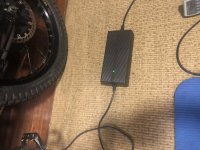In my experiences, the opposite has always been true.Comrade said:There is a 100% chance that you will get more range (more energy out of the 2 packs) if you drain one battery pack, disconnect it, and then connect the second pack and drain that.
For me, paralleled packs of same cell type and voltage, regardless of differences in age and capacity and cell quality, give greater range (more total Wh) than any of them by themselves.
I suppose if you used packs so large that they were capable of far more current output than the system would ever draw even at peak, and so had no voltage sag and no internal losses to heat, then you would get about the same range / Wh whether paralleled or not.
But I haven't had a case yet where running the packs empty one after the other ever got more range / Wh than running them paralleled. (again, assuming same cell type (chemistry) and pack voltage (number of series cells).



